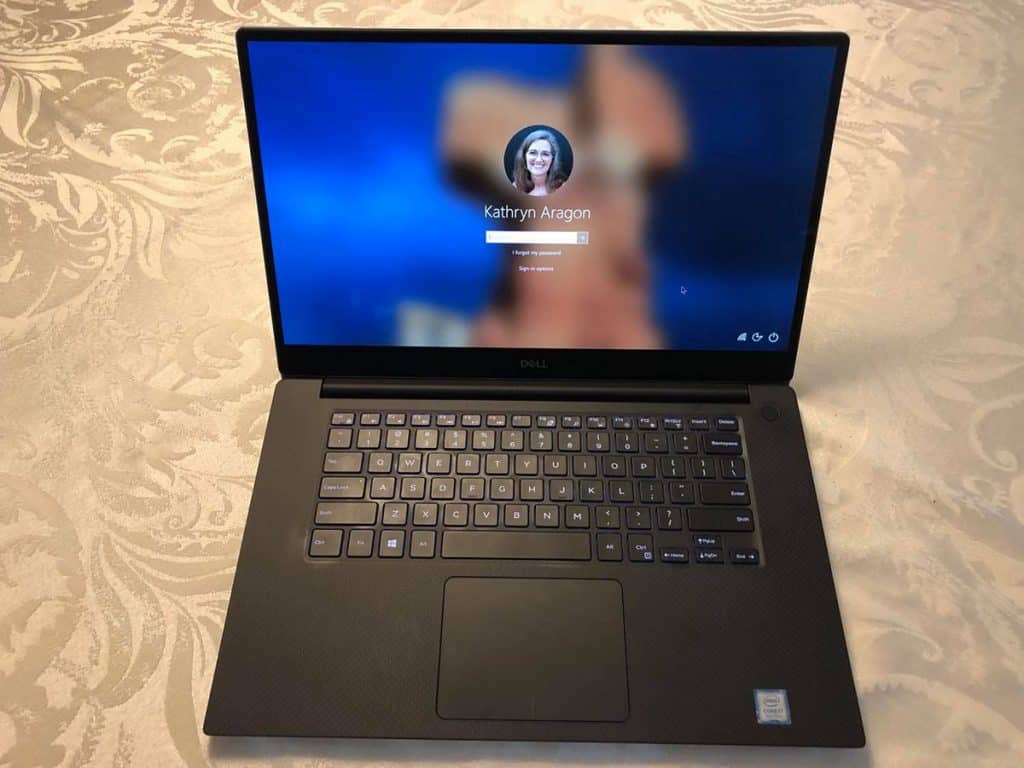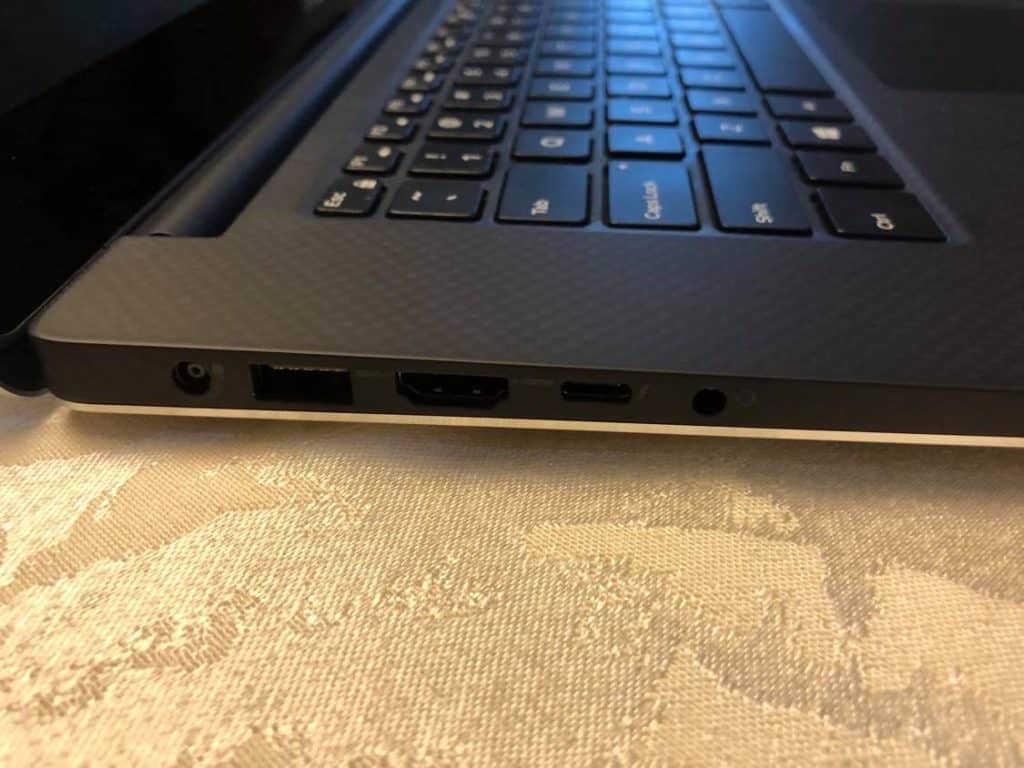Content creators aren’t your typical tech consumers. We need high-end products because of what we do, not because of what those products say about us. So though we aren’t always hard-core techies, we choose computers that have whatever specs we care about.
Dell’s XPS 15 (7590) is a good example of a computer that was designed for creators. With 16 gig of RAM and a good graphics card, it’s billed as one of the best computers on the market today for video work.
But is it?
Keep reading for my review, not as a techie but as a content expert.
Some Background
Today’s content involves a lot of video, so when I was in the market for a new computer in late 2019, I decided to find one specifically designed for video.
My Google search: “best computer for video editing.”
To give you a little background, I’m not a newbie to tech. I was using computers professionally before Windows had been invented. (Back then it was DOS on amber screens.)
That said, I don’t follow the latest trends and I’ve never needed to have the latest and greatest technology. What I do care about is quality.
Dell XPS 15 (7590) is listed among the top three computers for video production, so it got my attention.
Sure, it was more expensive than I wanted to spend — a cool $1,808.99 before taxes — but I was more than willing to make the investment if it would help me create better content.
Sadly, 9 months later, I’m not only disillusioned, I’m unlikely ever to buy a Dell again.
Bottom line, if you’re a content creator, especially a video creator, you’ll do better to look elsewhere.
Details
The Dell XPS 15 comes with all the components you’d expect in a professional-level computer.
The processor is a 9th Generation Intel Core™ i7-9750H. Not the latest generation, but it’s a good processor.
16GB of RAM is the minimum you should have as a content creator. The XPS has that, along with 512GB of memory on a Solid State Drive.
512GB isn’t a lot, so you’ll need to be careful about saving a lot of software or video files to your hard drive. I also recommend against downloading Dropbox — it will max out your memory quickly. But keeping those things in mind, this is plenty of operational power for doing advanced content creation.
The camera is good: a 720p integrated widescreen. The NVIDIA GeForce GTX 1650 graphics card isn’t top-of-the-line, but it’s acceptable. (It isn’t good enough for a gaming computer, but for graphics and videos, it will do the job.)
The display is one of the best you’ll find in a PC: OLED InfinityEdge Anti-Reflective. It’s not a touch screen, but that’s okay. Touch screens often come at the expense of another, more valuable feature.

If you create your own graphics or illustrations, you need this display. Books require high-def screenshots that you can only get on a 4K monitor. And you’ll love the resolution when you’re working on graphics.
The XPS 15 also comes with a lot of the modern high-tech features you’d expect from a high-end computer:
- Ports: 1 HDMI v2.0 port, 1 Thunderbolt™ 3 with Power Delivery and DisplayPort, 2 USB 3.1 Gen 1 port, 1 Universal audio jack
- Slots: 1 SD-card reader, 1 wedge-shaped lock slot
- Fingerprint Reader integrated into the power button
First Impressions
You’ll impress your friends and family with the XPS’s 4k monitor. I have a techy family, and even the IT expert and philosopher gamer were impressed with the XPS’s display. The colors are vibrant and the edges are razor sharp.
Set-up is easy. Just follow the wizard, as with any PC. The keyboard and touchpad feel good too. Nothing remarkable there.
I will say the power button feels cheap, like it might someday get stuck. Rather than having a good spring to it, after it’s compressed, it feels like it rises into place unevenly.
Honestly, that caught me off guard. After spending $2k on a computer, I expect the power button to feel solid.

Pros & Cons
The XPS really is a joy to work on. The resolution of the display is amazing. But it works best if you only keep a few windows open and limit your use of memory-intensive apps.
Unfortunately, for content creators, that’s not usually the case.
I tend to work with a window open for each active project, each with lots of tabs. All my online apps are in another window. And I likely have Adobe Photoshop and Acrobat running in the background.
In other words, I run my computers pretty hard.
Because of this, I usually buy gaming computers. I made an exception this time because I was specifically looking for a computer that was recommended for video. The XPS was one of the best — so from my perspective, it should have been able to handle my daily computing needs as well.
But it didn’t take long to realize that it wasn’t up to snuff.
First, it runs hot. The fans are constantly blowing, and I constantly have to stop to close any tabs that aren’t essential to what I’m doing. Even with 16 GB of RAM, computing seems hard for the XPS.
Another thing I’ve noticed is that there aren’t enough USB ports. If you have a USB microphone and several wireless devices, you’re going to need to get a USB hub to handle them all.
As for the battery, it lasts four to six hours — not bad, but as long as it should.
Extreme Issues with Video
The biggest problem with Dell’s XPS 15 is actually the feature I bought it for — video.
I did a few videos when the computer was new and I was impressed with the HD output. Awesome!
But within a few months, the video started breaking up during recording sessions. It wasn’t static, per se. It was more like I was in the matrix.
I tested every variable I could think of: the recording software, the camera, the second monitor, the way I held my mouth. Everything.
I ran diagnostics, and there was no obvious problem with the graphics card. I then tried updating drivers and software. For a day, that worked, so from then on, I tried doing updates the moment they were available.
Even so, every time I did video, I had the same matrix-y spasms, along with other interesting issues.
On one Zoom call, I was told my voice sounded tinny, that I should probably start using an external microphone. And when I tried to share my screen on Zoom, the display began blacking out every other second until my computer shut down.
Dell’s service has been responsive, but it hasn’t resolved the computer’s issues with video.
They ran diagnostics and got the same results I did. They recommended updating things right away, which I was already doing. We had to push to get them to go any further than that.
Finally, Dell replaced the camera. That helped the matrix weirdness, but not the Zoom black-outs or the microphone issue.
They then replaced the motherboard, which holds the graphics card. Sadly, the Zoom and mic problems persist.
Our own research has uncovered a known issue: the 3D settings on the NVIDIA card need to be customized for Zoom. Trouble is, you can’t get to those settings. We’re still trying to figure this one out.
Bottom Line
On the Dell XPS 15, a computer highly recommended for video, you can’t use Zoom and video recording is iffy.
My solution? I’ve purchased a new computer and retired the XPS. We’re hoping Dell will make it functional, but I can’t trust it for the content creation and client work I do on a daily basis.
I’m not sure how this computer has made the #1 and #2 spots on every video production list. After my own experience with it, I can’t recommend to anyone doing more than writing, emailing, and watching videos.
But let’s be honest, you don’t need to spend $2k on a computer for those tasks. If you see a Dell XPS 15, keep looking. It’s not the workhorse you need as a content creator.
The Specs of My Machine
- McAfee Small Business Security 12-month subscription (CB)
- Fixed Hardware Configuration
- Backlit English Keyboard with Fingerprint Reader
- Additional Software
- Regulatory Label
- XPS 7590 System Management Software
- Silver
- XPS 15 7590 Shipping Material
- 6-Cell 97WHr Integrated
- E5 Power Cord for 3-pin Adapter (US/China)
- NVIDIA(R) GeForce® GTX 1650 4GB GDDR5
- Killer Wi-Fi 6 AX1650 (2×2) and Bluetooth 5.0
- 512GB M.2 PCIe NVMe Solid State Drive
- 15.6″ 4K UHD (3840 x 2160) OLED InfinityEdge Anti-Reflective Non-Touch 100% DCI-P3 400-Nits display
- Driver for Wireless 1650
- 16GB DDR4-2666MHz, 2x8G
- No AutoPilot
- Windows 10 Pro (64bit) English
- 9th Generation Intel Core™ i7-9750H (12MB Cache, up to 4.5 GHz, 6 cores)
- 130W Power Adapter
- Accidental Damage Service, 1 Year
- Onsite/In-Home Service After Remote Diagnosis, 1 Year
- Dell Limited Hardware Warranty Initial Year


